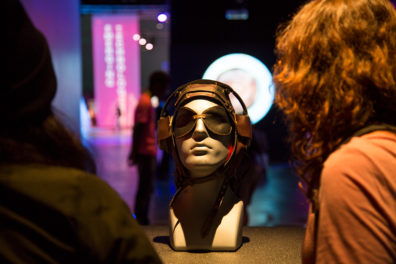
Sachi uses the microfade tester to measure light-induced color change of a pastel sample.
In a white room, a ray of light beams down on a scribble of pastel. I lean over the machine producing the light, while watching the nearby monitor for signs of pigment fading. In an adjacent room, scientists indent thin cross-sections of paint to better understand how certain artist’s materials age. On the floor above us, other researchers envision new ways to preserve and analyze plastics. I am not sitting in a university lab or an industrial research facility; I am at the Getty Center, home not only of fine artwork and lush gardens, but also the Getty Conservation Institute (GCI).
I spent this summer at the Conservation Institute as part of the Getty’s Multicultural Undergraduate Internship program. I am majoring in chemistry and materials science, subjects which suit me perfectly for working in the GCI’s Science department. Here, scientific techniques are employed to further the preservation of cultural heritage through research. Most people are surprised to learn the Getty has labs filled with research equipment and scientists fluent in the languages of physics, chemistry, and materials science.
My main job during my internship has been learning about the Microfade Tester (MFT), a device that measures how art fades with exposure to light. I used this device on an assortment of materials, ranging from swatches of pastels and dyed wools to a sample from a Jackson Pollock painting. The MFT fades objects at an accelerated rate by aiming a strong and extremely narrow column of light at a specific area. The machine measures the resulting color change, and the data helps museums decide how long an object can be safely displayed before perceptible fading occurs. I spent many hours training on the MFT, but summing up my internship with only this one task would not be doing my time here justice.

Inserting dataloggers into a humidity-conditioned chamber to check performance.
I participated in a wide variety of activities as an intern in GCI Science. From my experiences, I not only gained hands-on laboratory experience, and became more acquainted with the field of conservation science, but I also learned what it means to be a scientist. The staff and project meetings I attended at the Conservation Institute have given me a taste for the amount of careful planning and scientific know-how it takes to do research. I learned the importance of documenting one’s processes and practiced documentation myself, by working on a database of past MFT studies and by collecting published material on MFT in a bibliography. One early morning, I even satisfied my lifelong desire to have a museum nearly all to myself when I wandered through the galleries before visiting hours with a particulate meter to begin establishing baseline particulate levels in spaces across the Getty Center.

Vincent Beltran, assistant scientist, in the lighting research lab using a fadeometer to determine light sensitivity. Photo: Scott S. Warren
A number of the Conservation Institute’s scientists sat down with me for lunch to tell me about their research. From these sessions, I’ve learned how indentation, a technique employed in materials science, reveals how artist materials react to stress and how X-ray fluorescence reveals what pigments were used in a painting. As someone with a science background who has always loved art, it’s thrilling to hear about how the very same concepts I am learning at school are applicable to humanity’s creative achievements. Who knew that a fondness for the periodic table and a degree in physical science could be used in the service of an O’Keeffe watercolor or a Pollock painting?

Taking a particulate reading to find out how much dust is in the air.
I came into this internship with only vague ideas of what conservation science was. I am coming out of it surprised with how much it echoes the world of hard science I know and love from university. It is true that scientists in the conservation field have different audiences than those in traditional labs, but the same dedication to thorough and deep research exists in the field of conservation science. My internship has convinced me this is a path I definitely want to explore further, and I leave the Conservation Institute feeling only more excited for my future.




Comments on this post are now closed.